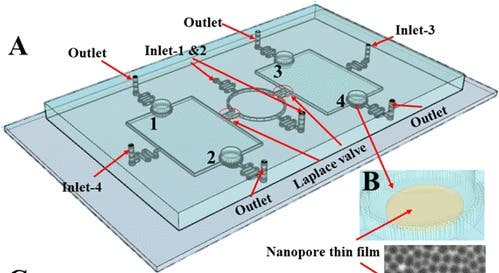Breakthrough sensor chip is 10x more sensitive at disease diagnostics
The new technology shows promise for rapid, low-cost point-of-care diagnostic capabilities in plants, foods, animals and humans.

[June 28, 2023: Laura Muntean, Texas A&M AgriLife Communications]
The new technology shows promise for rapid, low-cost point-of-care diagnostic capabilities in plants, foods, animals and humans. (CREDIT: ACS Sensors)
Texas A&M AgriLife Research scientists and collaborators at Iowa State University have developed a sensor chip that can detect many disease pathogens with 10 times the sensitivity of currently available methods.
The chip also eliminates the need for chemical dye reagents typically used in the diagnostic process. The new technology shows promise for rapid, low-cost point-of-care diagnostic capabilities in plants, foods, animals and humans, including detecting foodborne pathogens, bird flu and COVID-19.
An abstract diagram showing the basic configuration of the LAMP reaction chamber and nanopore film sensor containing immobilized LAMP products (Texas A&M AgriLife Illustration)
Results from the new sensor are available in about 30 minutes.
In their research, published in ASC Sensors, scientists used the new sensor to detect Phytophthora infestans. The pathogen causes globally devastating late blight disease — a particular threat to potato and tomato crops.
Related Stories
The research was co-led by Jinping Zhao, Ph.D., AgriLife Research postdoctoral research scientist in Dallas, and Subin Mao, a Ph.D. candidate in electrical and computer engineering at Iowa State University. Serving as corresponding authors were collaborators Junqi Song, Ph.D., associate professor and plant immunity research lead with AgriLife Research in Dallas, and Long Que, Ph.D., professor of electrical engineering at Iowa State University. Seed grants from each university funded the research.
“This research advances technologies that have emerged as some of our greatest opportunities for improving agriculture, food safety and human health,” Song said. “Our publication represents a step toward realizing these powerful tools against diseases.”
Building on existing technologies
The new sensor improves upon a technique known as loop-mediated isothermal amplification, or LAMP, which is widely used to detect pathogens by amplifying their DNA.
An abstract diagram showing the basic configuration of the LAMP reaction chamber and nanopore film sensor containing immobilized LAMP products (CREDIT: Texas A&M AgriLife Illustration)
Detection of LAMP products amplified from templates, such as pathogen DNA, often requires that the products be “labeled” by using fluorescence dyes — a costly process with low sensitivity.
The new sensor diagnoses pathogens without such reagents and at high sensitivity. It also eliminates a lengthy DNA purification process that creates challenges for point-of-care use.
Integrated Sensing Chip for Ultrasensitive Label-Free Detection of the Products of Loop-Mediated Isothermal Amplification. (CREDIT: ACS Sensors)
The new chip consists of a nanopore thin-film sensor inside a special reaction chamber. Primers are uniquely designed to be immobilized on the nanofilm, causing amplified LAMP products to become bound to the sensor, which produces signals that can be directly and easily measured with a portable spectrometer.
What’s next
The LAMP chip offers a new portable platform to detect pathogens using label-free sensors with ultrasensitivity. The research team will now work to further enhance sensitivity to a subattomolar or even lower level.
A photo showing two battery-operated heater strips bonded to the bottoms of the reaction chambers of a LAMP chip. The heater strips are connected to a temperature digital controller to provide and maintain 65 C during LAMP reactions. (CREDIT: ACS Sensors)
The team aims to offset current challenges to detecting and distinguishing pathogen species and strains with high-sequence similarities. They will also work to improve the specificity of detections and establish quantitative detection by integrating artificial intelligence and CRISPR gene-editing technologies.
Their goal is to achieve a viable product for broad adoption in plant, animal and human health point-of-care applications.
Note: Materials provided above by Texas A&M AgriLife Communications. Content may be edited for style and length.
Like these kind of feel good stories? Get the Brighter Side of News' newsletter.
Joseph Shavit
Head Science News Writer | Communicating Innovation & Discovery
Based in Los Angeles, Joseph Shavit is an accomplished science journalist, head science news writer and co-founder at The Brighter Side of News, where he translates cutting-edge discoveries into compelling stories for a broad audience. With a strong background spanning science, business, product management, media leadership, and entrepreneurship, Joseph brings a unique perspective to science communication. His expertise allows him to uncover the intersection of technological advancements and market potential, shedding light on how groundbreaking research evolves into transformative products and industries.



